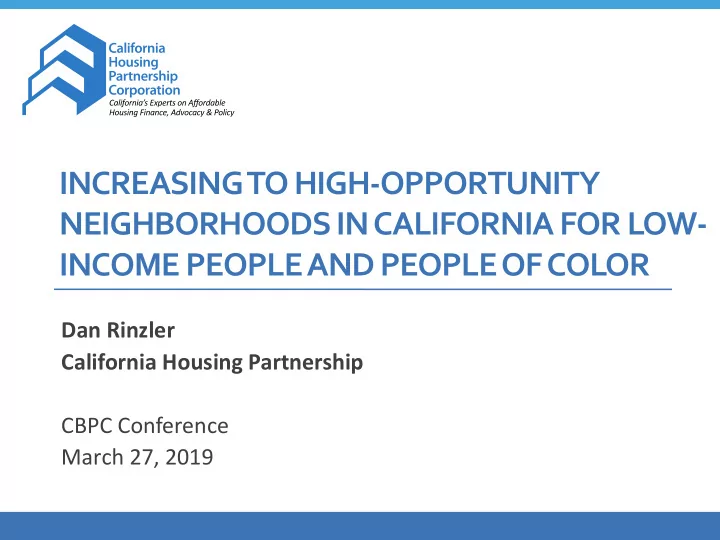

INCREASING TO HIGH-OPPORTUNITY NEIGHBORHOODS IN CALIFORNIA FOR LOW- INCOME PEOPLE AND PEOPLE OF COLOR Dan Rinzler California Housing Partnership CBPC Conference March 27, 2019
About the California Housing Partnership • Created by the State Legislature in 1988 (no ongoing state funding). • Work across California with nonprofit and government housing agencies to create and preserve housing affordable to lower- income households. • In 30 years, our staff has helped private and public housing agencies leverage $18 billion in funding to create and preserve more than 70,000 affordable homes . • Also provide research and leadership on housing policy and funding issues. California Housing Partnership | 2
Post-war redlining + other racist housing policies created a racially segregated geography of opportunity California Housing Partnership | 3 Source: University of Richmond Digital Scholarship Lab, 2019. “Mapping Inequality: Redlining in New Deal America.”
Neighborhoods account for most of the variation in long- term earnings of children from low-income families Source: Opportunityatlas.org. Results shown for children whose California Housing Partnership | 4 parents were low-income (all races and genders).
Race appears to be a stronger determinant of who lives in high-resource neighborhoods than income San Francisco Bay Area (2015) California Housing Partnership | 5 Source: U.S. Census, American Community Survey; California Fair Housing Task Force, 2018.
Segregation patterns do not reflect actual location preferences of people of color Data cited from a 2004-2005 survey conducted in Cook County, Illinois (which includes Chicago). Source: Krysan, et al. California Housing Partnership | 6 2015. Diverse Neighborhoods: The (mis)Match Between Attitudes and Actions. PRRAC, Poverty & Race, Vol 24, No. 4.
Recent trend of re-segregation: as housing prices rose from 2000-2015, the racial geography of the Bay Area shifted Change in low-income Black households (2000-2015) California Housing Partnership | 7 Source: U.S. Census, American Community Survey
Low-income households of color were more vulnerable to rent increases than low-income White households 30% tract-level increase in median rent (adjusted for inflation) in Bay Area from 2000-2015 associated with: 28% decrease in low- income households of color No relationship with number of low-income Change in median rent paid, 2000-2015 White households (% change, inflation-adjusted) California Housing Partnership | 8 Source: U.S. Census, American Community Survey
The landscape of high-poverty & racially segregated neighborhoods in the Bay Area shifted between 2000 & 2015 California Housing Partnership | 9 Source: U.S. Census, American Community Survey
The landscape of high-poverty & racially segregated neighborhoods in the Bay Area shifted between 2000 & 2015 California Housing Partnership | 10 Source: U.S. Census, American Community Survey
Displacement & migration of low-income people of color contributed to new concentrations of segregation and poverty California Housing Partnership | 11 Source: U.S. Census, American Community Survey
Geography of opportunity in the Bay Area “resources” = tract-level predictors of upward economic mobility for low-income children California Housing Partnership | 12 Source: California Fair Housing Task Force, 2018.
Access to high-resource neighborhoods more pronounced between racial groups than between incomes of same race California Housing Partnership | 13 Source: U.S. Census, American Community Survey; California Fair Housing Task Force, 2018.
State and local housing policy & investments should affirmatively help low-income people of color live in anyneighborhood & reduce neighborhood inequality 1. Create new affordable homes in high-resource neighborhoods; 2. Stabilize housing prices and protect tenants neighborhoods where prices are rising fastest; and 3. Increase economic opportunity and institutional supports in racially segregated, high-poverty neighborhoods. California Housing Partnership | 14
California Housing Funding Agency (TCAC/HCD) Opportunity Map Indicators & Filters DOMAIN INDICATOR Poverty Adult education Economics and Employment Mobility Proximity to entry-level jobs Median home value Health and CalEnviroscreen 3.0 indicators Environment Math proficiency Reading proficiency Education High school graduation rates Student poverty rate Filter (for “lowest Racially segregated and high-poverty resource” tracts) California Housing Partnership | 15 Source: California Fair Housing Task Force, 2017
Family new construction 9% LIHTC affordable housing STATEWIDE (2003-2015) 16,000 14,000 AFFORDABLE HOMES 12,000 10,000 8,000 6,000 4,000 2,000 0 High Low Moderate High Highest Segregation Resource Resource Resource Resource & Poverty TRACT CATEGORY IN TCAC MAP California Housing Partnership | 16 Source: California Fair Housing Task Force, 2017
Land use challenge: lack of available multifamily sites in higher resource neighborhoods MappingOpportunityCA.org - new mapping tool to inform zoning reform proposals California Housing Partnership | 17
New and Proposed State Laws + Resources • 2018 • Props 1 & 2: $6 billion for creating and preserving affordable homes • AB686: creates AFFH requirement for California • AB1771: introduces AFFH goals in Regional Housing Needs Allocation Process • 2019 • Replacement for affordable housing funding lost due to eliminating redevelopment agencies in 2011 (SB5, AB11) • New $ for State low-income housing tax credit? (AB10) • Zoning reform (SB50/AB1279) California Housing Partnership | 18
CONTACT Dan Rinzler California Housing Partnership drinzler@chpc.net
Recommend
More recommend